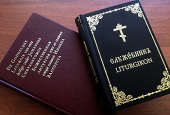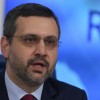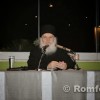 On November 16, 2013, the Church of St Nicholas in Amsteram, the Netherlands, hosted the presentation of a new translation of the Liturgy of St John Chrysostom into Dutch, published in two versions, for clergymen and laity.
On November 16, 2013, the Church of St Nicholas in Amsteram, the Netherlands, hosted the presentation of a new translation of the Liturgy of St John Chrysostom into Dutch, published in two versions, for clergymen and laity.
This effort was a joint project by representatives of various Orthodox jurisdictions, parishes and monasteries in the Netherlands. After its completion, the ruling bishops of the Moscow and Constantinople Patriarchates, as well as the Exarchate of the Western European Russian Orthodox Churches, gave their blessing for the use of this translation as the basic liturgical text in the parishes of their Holland dioceses.
His Eminence Archbishop Simon of Brussels and Belgium opened the event, in which representatives of the Constantinople, Romanian and Serbian Patriarchates and the Exarchate of the Constantinople Patriarchate took part, as did the Editor-in-Chief of the Journal of the Moscow Patriarchate, Sergei Chapnin.
Two lectures read that day were devoted to the history of the translation of liturgical texts into Dutch, as well as the principles and exceptions of this new version.
Priest Hildo Bos of St Nicholas Church in Amsterdam noted that a special situation developed with regard to the translation of liturgical texts in Holland. Over the course of 200 years, there seven versions prepared, some of which were broadly published. The very first version is no longer extant, though its search continues; it is known that it dates back to 1760 and was translated from the Greek for scholars who visited the Greek-Russian Church of St Catherine in Amsterdam. The second translation was made from a German-language original in 1829.
The most well-known and most widely available translation was done by Archimandrite Adrian (Korporaal) of St John the Forerunner Monastery in The Hague in 1968. Notably, for many years Bishop John (Maximovich, known as St John of Shanghai—transl.) fervently supported translating work, and that book of translations emphasized his role as an inspiration and benefactor of the effort.
At the turn of the 21st century, as a result of evolving changes in the Dutch language, a new translation became necessary. With this aim, an editorial committee was established in 2009 comprised of Abbess Maria (Hulsker), Protopriest Sergei Ovsyannikov, Priest Hildo Bos, Deacon Michel Bakker, Nun Makrina (Yilderd) and Hanno Eutenbogaart.
The main work was done by Abbess Maria of the Convent of the Nativity of the Most-Holy Mother of God in Asten. In her speech, she discussed the problem of a lack of a critical edition of the text of the Liturgy of St John Chrysostom in Greek, as well as the principles she adhered to in doing the translation, noting that the text of the Liturgy itself for all Orthodox jurisdictions was the same, while liturgical instructions in various Local Churches have significant differences, which were not included in these instructions.
A new project was also announced at the event: a special internet library at www.orthodoxeteksten.nl. Its creators aim to gather all liturgical, patristic and other church texts available in the Dutch language.
“Editions of many books have long been unavailable, and they are unlikely to be reprinted, some materials were published on the parish level and were never made widely available,” noted Fr Hildo. “But we are prepared to scan and post all such texts that we are able to collect for anyone to access, and obtain their copyrights if need be.”
In conclusion, Fr Sergei, Rector of St Nicholas Church in Amsterdam, noted that with the blessing of Bishop Simon, the new text will be used in divine services beginning on November 17.
The liturgy for laity was financed by a grant from “Orthodox Initiative,” and will be distributed free of charge at all parishes. The new publication of the service-book was prepared with the assistance of the Monastery of St Job of Pochaev in Munich of the Russian Orthodox Church Outside of Russia.
Source: ROCOR
















